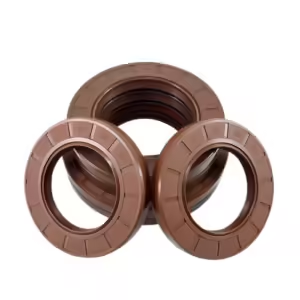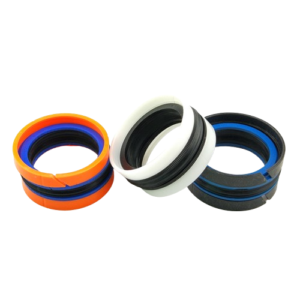What is a Shaft Seal?
Introduction
A shaft seal is a critical component in countless industrial and mechanical systems. Its primary function is to prevent the leakage of fluids and the ingress of contaminants around rotating or reciprocating shafts. By maintaining a secure seal, it helps ensure system integrity, prolong equipment life, and optimize performance. Broadly speaking, shaft seals are designed for two main types of shaft movement: rotational and reciprocating. Understanding the differences between these types of seals is crucial when selecting the right solution for your specific application.
1. Shaft Seals for Rotational Movement
Rotational shaft seals are widely used in systems that feature continuous circular motion. They are commonly found in automotive drive shafts, gearboxes, motor shafts, half-shafts, and any other application where a shaft rotates at various speeds.


Applications
Rotational seals are prevalent in:
- Automotive transmissions and drive assemblies
- Electric motor shafts
- Gearboxes and bearing housings
- Pump and compressor shafts
Material Composition and Design
These seals typically consist of a metal skeleton chemically bonded to a rubber element. The rubber lip forms the sealing interface against the shaft, while the metal skeleton provides crucial structural support.
Why Metal Skeletons Are Essential
The metal skeleton ensures the seal maintains its shape and performance under the high torsional stresses associated with rotation. As the shaft spins at varying speeds, significant forces are exerted on the seal. Without the metal reinforcement, the seal could deform or fail prematurely. In fact, more than 99% of rotational shaft seals incorporate a metal skeleton, with exceptions generally reserved for ultra-low-speed applications (under 1 RPM), where torsional stress is negligible.
Common Types of Rotational Shaft Seals
Some frequently used seal types include TC/FB, SC, DC, TB, and TG designs. Certain applications call for an exposed metal skeleton, which can enhance stability or facilitate custom installation.
2. Shaft Seals for Reciprocating Movement
Reciprocating shaft seals are designed for environments where the shaft moves back and forth rather than spinning continuously. Such systems are often found in hydraulic and pneumatic machinery.


Applications
Common uses of reciprocating seals include:
- Hydraulic cylinders in engineering machinery
- Injection molding machine cylinders
- Coal mine hydraulic supports
- Household hydraulic jacks
Material Composition and Design
Reciprocating seals are commonly produced from polymer-based materials like polyurethane (PU), NBR (nitrile rubber), or FKM (fluoroelastomer). Unlike their rotational counterparts, they do not require metal skeletons. These seals must endure friction on both their inner and outer diameters due to the linear motion, and a hard metal component could severely damage the cylinder’s surface over time.
Why Metal Skeletons Are Not Used
In a reciprocating system, friction is not isolated to a single lip interface. Instead, there is continuous contact and movement along multiple surfaces. A metal skeleton could cause excessive wear, scraping the cylinder wall or seal groove as the shaft moves in and out. By relying solely on polymer materials, reciprocating seals can flex and maintain a tight seal without damaging the surrounding components.
Common Types of Reciprocating Shaft Seals
Typical reciprocating seal types include UN, USH, and KDS/DPM combination seals. These variants are tailored to handle the unique demands of back-and-forth motion.
3. Key Differences Between Rotational and Reciprocating Shaft Seals
- Motion Type:
- Rotational seals operate with shafts that spin continuously.
- Reciprocating seals work with shafts moving linearly, back and forth.
- Structural Design:
- Rotational seals generally include a metal skeleton to withstand torsional forces and maintain shape.
- Reciprocating seals avoid metal reinforcements, relying instead on flexible polymers to prevent damage from dual-surface friction.
- Material Selection:
- Rotational seals typically combine metal and rubber, such as TC seals.
- Reciprocating seals are often made from polyurethane, NBR, or FKM for their flexibility and wear resistance in linear applications.
4. Special Considerations for Shaft Seal Selection
When choosing a shaft seal, several factors must be carefully evaluated:
- Rotational Speed and Torsional Stress: Higher speeds and greater torsional forces call for more robust designs, typically involving metal skeletons.
- Environmental Factors: Temperature, pressure, and chemical exposure all influence material selection and seal geometry.
- Fluid Compatibility: Ensuring the sealing material is chemically compatible with the system’s fluids is essential for long-term reliability and performance.
Conclusion
Shaft seals, whether designed for rotational or reciprocating applications, play a pivotal role in maintaining system integrity and preventing downtime. The correct selection and application of a shaft seal can significantly extend equipment life, reduce maintenance costs, and optimize overall efficiency. By considering the type of motion, structural requirements, material compatibility, and operating conditions, you can ensure that you choose the right seal for your application.
For more information about shaft seals and professional rubber sealing solutions, visit drorubber.com or contact us directly:
WhatsApp: +0086 15815831911
WeChat: +0086 13784044874
Our experienced team will provide guidance and tailor-made solutions to help you achieve optimal sealing performance for your systems.





